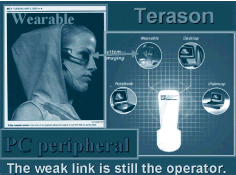Ultrasound and the Internet
The diagnostic sonography (ultrasound) profession is populated by technophiles. In general, people who gravitate to ultrasound are not afraid of technology or computers. For this reason alone, it is not surprising that sonographers and sonologists have flocked to use the Internet and the World Wide Web (WWW) for education, consultations and communications with colleagues across the globe.
The diagnostic sonography (ultrasound) profession is populated by technophiles. In general, people who gravitate to ultrasound are not afraid of technology or computers. For this reason alone, it is not surprising that sonographers and sonologists have flocked to use the Internet and the World Wide Web (WWW) for education, consultations and communications with colleagues across the globe. The number of people using the Internet is increasing rapidly worldwide, and medical websites are increasing exponentially. The Web is a graphic mode of communication and it is natural that ultrasound images would be exchanged and discussed via this new medium.
Before the Web was invented, many medical professionals around the world had begun to communicate via email and list servers or discussion groups. The earliest list for OB/GYN discussion was OBGYN-L, established in 1995 by Dr Geffrey H. Klein while he was a resident at Baylor School of Medicine in Houston. In 1996 OBGYN-L went onto the Web, the power of the Web was recognised for the sharing of visual information such as ultrasonograms ... and Ultrasound@OBGYN.net was born in November 1997 [1].
“The Web is a graphic mode of communication and it is natural that
ultrasound images would be exchanged and discussed via this new medium.”

International consultation and discussion
Since its start, this (now Web-based) forum (http://forums.obgyn.net/ultrasound/) established a peer-review system for publishing interesting cases, and has assisted in many difficult situations around the world. This discussion forum is designed for professional healthcare workers using sonography in women’s health and includes some of the luminaries of ultrasound worldwide.
This is the highest and best use of the Web in medicine. The ability to display images quickly and get responses from many international experts is a remarkable advance in world health. However, we must caution that to give a second opinion long distance is not necessarily good medicine. While we can be enthusiastic about this new medium, the physician managing the case must remain in control and use her/his good judgment about any information or advice received from the Internet.
“The ability to display images quickly and get responses from many
international experts is a remarkable advance in world health.”
Links to other sites
The OBGYN.net was the first and is still the largest website dedicated to women’s health issues, with many links to other sites. It has just begun a new service for its healthcare professional membership, which now has free access to the Cochrane Library of medical trials via the Web. This is a great new service.
Table I provides a full listing of the OBGYN.net offerings. A large number of websites dealing with all aspects of ultrasound and sonography are now available. The table is by no means an exhaustive list, but contains many important sites. Almost all commercial manufacturers have sites, but these are not listed here. Most manufacturers can be found by using a Web search engine, or by simply typing in www.[manufacturer name].com. Almost all of the websites mentioned will have links to other sites of interest, so from this list an even larger number of sites can be located.
Table I: OBGYN.net links to other sites
Continuing medical education
Continuing medical education (CME) is also increasingly available on the Web. Many of the sites charge a fee, but some are free (most of the free sites are sponsored by equipment manufacturers). A few of the CME sites are listed in the table but many more can be found by searching the Web. A search in preparation for this topic brought 14,780 hits, or CME sites. Limiting the 14,780 sites to only those that include ‘ultrasound’ resulted in 618 hits. So there seems to be ample medical education available.
There are a number of compact disks (CD-ROMs) that have been developed for educational purposes. While the contents of these CDs are not necessarily on the Internet, they are a form of computer-aided instruction. The number of educational CDs for sonography is increasing rapidly, many of them being published as supplements to textbooks. Some of the CDs available are listed in the table.
Intranets

One of the most powerful uses of the Web will be for Intranets: web pages for communication within an institution or clinic. These will often be blocked to outside users, but will assist ultrasound departments by allowing archived images and medical records to be moved quickly from portable units to the central digital filing system. At this point the sonographer becomes a true ‘cyborg’ or cybernetic organism. Modern ultrasound equipment already has the facility to transmit images by IP/CP. One can imagine the sonographer, with his miniature sonographic machine/transducer, palm pilot, and tiny personal computer screen, easily moving around the hospital, sending images to central filing via a wireless LAN [2].
Improving education, information, healthcare
The Web is a relatively new mode of communication. Obviously there will be rapid improvements, via which we can only assume that education, the exchange of medical information and healthcare will be improved. If the digital divide between the technologically developed and those with less access to these advances can be bridged, then all will benefit.
References:
References
1. OBGYN.net; The Universe of Women’s Health: http://www.obgyn.net/us/us.asp; May 22, 2000.
2. Terason: http://www.terason.com/ Teratech Corporation; May 22, 2000.
Comments on this article can be sent to Ultrasound@obgyn.net
S1E4: Dr. Kristina Adams-Waldorf: Pandemics, pathogens and perseverance
July 16th 2020This episode of Pap Talk by Contemporary OB/GYN features an interview with Dr. Kristina Adams-Waldorf, Professor in the Department of Obstetrics and Gynecology and Adjunct Professor in Global Health at the University of Washington (UW) School of Medicine in Seattle.
Listen
